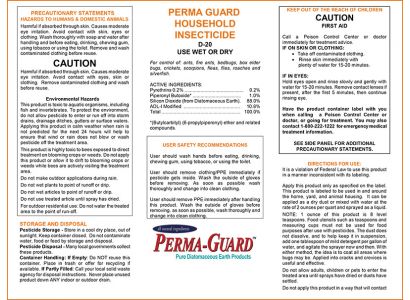Household Insecticides
For control of roaches, silverfish, ants, bedbugs, flies, fleas, box elder bugs, scorpions, crickets, and many others! Perma-Guard Household Insecticide products are licensed to be used in and around the home, yard, animal housing, etc.
Dry Application: for dry applications, an applicator is needed. Please take a look at the applicators we offer.
Perma-Guard Household Insecticide D-20 is effective on a variety of insects even though all insects do not reproduce in the same manner, like the same type habitat or have similar habits. Knowing the following information about the insects you are trying to eliminate combined with these instructions for use on the product bag will help you be successful in your efforts.
Silverfish
Silverfish are nocturnal insects about 0.51 to .098 inches long with abdomens that taper at the end. Their silvery scales and wiggling movement gives them the appearance of fish, thus their name. Silverfish are agile runners and can out run almost all their natural predators. They inhabit moist areas, requiring humidity of 75% to 95%. In urban areas, they can be found in attics, basements, bathtubs, sinks, kitchens, and showers. A female silverfish lays groups of fewer than 60 eggs at once deposited in small crevices. These eggs take from two weeks to two months to hatch. A silverfish usually lays fewer than 100 eggs in her lifetime. It can take three months to three years. Silverfish consume matter that contains polysaccharides, such as starches and dextrin adhesives. These include book bindings, carpet, clothing, coffee, dandruff, glue, hair, some adhesives. They are pests because they destroy books, wall paper and contaminate food. They do not transmit disease.
Cockroach
Cockroach reproduction relies on eggs from a female and sperm from a male like the Silverfish, but what happens after the eggs are fertilized varies from species to species. There are 70 different species of roaches in North America. Most roaches grow their young in eggs outside the mother’s body. In this species the mother carries her eggs around in a case attached to her abdomen. Others drop or hide this case shortly before the eggs hatch while other species continue to carry the hatching eggs and care for their young after they are born. Regardless of the process, the case of eggs must remain moist in order for the eggs to hatch. Perma-Guard Household insecticide D-20 can be dusted into the places eggs may hide or where the adult roach carries the case. The product is an irritant to the insects causing them to become agitated allowing the Diatomaceous earth to absorb the waxy cuticle and body fluids.
Other species grow the eggs inside the female’s uterus and the developing roaches feed off of the yoke in the eggs the same as those who are carried outside the body in a sac. The cycle of growth from hatching to adult varies greatly from a few weeks to two years. Some only live a few months while others live up to two years. Cockroaches generally prefer warm, humid, dark areas. Have you ever been in a home where there were none seen until you turned on a light in night and they were everywhere? They are omnivores and many species will eat anything including paper, clothing and dead bugs even their own kind. There are a few that only eat wood. You see those all over trees at lakes in humid states. Cockroaches live in groups and have an organized social structure. Studies have suggested that cockroaches have a collective intelligence made up of the decisions of an individual roach. They love tight spaces and secure hiding spaces. Therefore, dusting into cracks and crevices, openings around water pipes and sewer drains, along bases boards, cramped places in the garage or in the house is necessary. There are some species that live indoors and some outdoors. The outdoor roach is called a feral roach. Feral roaches may still end up indoors. The peri-domestic roaches can survive inside or outside the home. Ever wonder why a house would need to be treated month after month? Often it is because the main nest of roaches is outside and they go in and out. It is important to look around your home for nests under wood, covered sand or soil, and other dark warm and damp areas such as crawl spaces under a pier beam foundation of the house. All these areas must be treated to be successful in eradicating this type. Another type of roach is called domestic cockroaches. They live inside homes and garages only.
Fleas
Fleas prefer a warm, humid environment, with temperatures ranging between 70° and 90° Fahrenheit and a relative humidity of 75% or more. Under ideal conditions, the cat flea (most common flea on most animals in the US) life cycle takes just 18 days, from egg to adult. Both male and female adults require a blood meal prior to mating. They prefer blood from your pet, but in the absence of a canine or feline host, fleas will bite people. The female flea may deposit up to 50 eggs per day on your dog or cat. An adult flea typically lives for several months, so just a single flea can cause a significant infestation in a short amount of time. Pets may get fleas from the outdoors or from being around other flea-ridden animals - both domestic or wild animals and feral cats. Additionally, people can carry fleas into the home themselves, from the same sources. Fleas jump from one host animal to another. The eggs are generally laid on the animal, but because they are not attached in any way, they will fall off onto carpeting, furniture, or other areas the animal may walk or lie. The eggs will hatch deep within these areas into larvae "worms," and eventually grow, through stages, into an adult that hops back onto an animal host to start the circle of life over again. There have been cases of housecats with fleas though they have never been outdoors. Fleas can jump through open screened windows from bushes up against the house onto your unsuspecting cat sunning on the window sill!
Perma-Guard Household Insecticide D-20 also includes active ingredients to kill ticks as well as fleas. In warmer areas the products should be used year round. In northern climates where insects become relatively inactive in the winter, use of the products can sometimes be limited to the potential flea seasons.
Scorpions
The male deposits a small container of sperm onto the ground then directs the female over to it so she can pick it up. The young develop in eggs inside the female, then after thirty five days to one year, 20-50 young hatches inside the female and emerge alive and crawl onto the mothers back. The mother protects them until they have molted (shed their exoskeletons) for the first time. Scorpions take from two to three years to reach sexual maturity and live for three to fifteen years. About 90 species are found in the U.S. All but four of these naturally occur west of the Mississippi River and are abundant in semi-arid regions. The highest concentration of scorpions is found in Arizona, California, New Mexico and Texas.
Scorpions are predatory. They often ambush their prey, lying in wait as they sense its approach. They consume all types of insects, spiders, centipedes and other scorpions. Larger scorpions may feed on vertebrates, such as smaller lizards, snakes, and mice if they are able to subdue them. They capture their prey with their pedipalps, paralyzing them with their venom as well if necessary. The immobilized prey is then subjected to an acid spray that dissolves the tissues, allowing the scorpion to suck up the remains. Scorpions are nocturnal and hide during the day. Some scorpions species will hide under rocks, logs and in cracks, other species will dig and hide in burrows some species of scorpions show more sophisticated social behaviors, like colonial burrowing, and living in familial groups that may share burrows and food. Use Perma-Guard Household Insecticide D-20 around the perimeter of your house. Store goods in your home and garage in plastic tubs, not cardboard boxes.
Tip: You can get a cheap black light at any home improvement store and use it to find and kill scorpions. Every one you kill is one that is not mating, breeding or coming inside your house. You can then treat the area they were hiding in.
Box Elder Bugs
Box Elder bugs are found primarily on box elder trees, as well as maple and ash trees. The adults are a little less than a half inch long with a dark brown or black coloration, with red wing veins and markings on the abdomen; nymphs are bright red. These highly specialized insects feed almost exclusively on the seeds of Acer species. Although they specialize on Acer seeds, they may pierce plant tissues while feeding. They are not known to cause significant damage and are not considered to be agricultural pests. Box elder bugs will release a pungent and bad-tasting compound when disturbed to discourage predators. This allows them to form conspicuous aggregations without being preyed on. Their congregation habits and excreta can annoy people; for this reason, they are considered nuisance pests. Removal of box elder and other Acer species can help in control of bug populations. They may form large aggregations while sunning themselves in areas near their host plant on rocks, shrubs, trees, and man-made structures). This is especially a problem during the cooler months, when they sometimes invade houses and other man-made structures seeking warmth or a place to winter. They remain inactive inside the walls and behind siding while the weather is cool. When the heating systems revive them, some may falsely perceive it to be springtime and enter inhabited parts of the building in search of food, water. In the spring, the bugs leave their winter hibernation locations to feed and lay eggs on maple or ash trees; aggregations may be seen during this time and well into summer and early fall, depending on the temperature.
House Crickets
House crickets take two to three months to complete their life cycle at 26 to 32 °C (79 to 90 °F). They have no special overwintering stage, but can survive cold weather in and around buildings, and in dumps where heat from fermentation may sustain them. Eggs are deposited in whatever damp substrate is available. Just before hatching, the head and eyes of the cricket are clearly visible. After 13 days at 86°F, the eggs hatch and the hatchlings squeeze out of the holes in the lid. Open the lid a crack and leave the dish in the terrarium for several days to allow all eggs to hatch. Just before hatching, the head and eyes of the cricket are clearly visible. After 13 days at 86°F, the eggs hatch and the hatchlings squeeze out of the holes in the lid. Open the lid a crack and leave the dish in the terrarium for several days to allow all eggs to hatch. House crickets take two to three months to complete their life cycle when reared at 80 to 90°F. They have no special overwintering stage, but survive cold weather in the northern States and Canada in and around buildings and in dumps, where heat from fermentation may sustain them. Once a cricket reaches the adult stage of development, it typically only lives about three weeks or so. If it is indoors and cannot find food, it may die even faster, the exception the camel or cave cricket which can survive two or more years.
House Fly
The life cycle of a house fly begins in the egg stage. A female house fly is capable of laying up to 150 eggs in a batch. Over a period of a few days, she will produce five or six batches of eggs. Female house flies favor damp, dark surfaces such as compost, manure and other decomposing organic material for egg laying. During a warm summer conditions are perfect for a housefly cycle to go from fertilized egg to adult in seven to 10 days. Female house flies favor damp, dark surfaces such as compost, manure and other decomposing organic material for egg laying. Potted plants in the house are a prime location as are planter boxes and flower beds around the house. When adding compost to the lawn, it would be wise to mix in and spread some Perma-Guard Garden and Plant Insecticide to address flies. The life span ranges from 15 to 30 days. With such a short life cycle, flies multiple rapidly, exposing their human hosts to high risks of disease at a transmission rate that is among the highest there is in the insect world.
Bed Bugs
Bed bugs are one of the most dreaded insects on the planet. Their bite is painful and many people experience blistering. Nymphs are nearly invisible but after biting a person and gorging on blood they turn a deep, mahogany red and swell to double the size of a ladybug. They drop sickly sweet smelling blood-infused feces all over the bed. Infestations can be detected by welts and irritation caused by bites, fecal smears and blood spots on the pillow cases, sheets and mattresses. Eggs are laid in cracks and crevices. They are long, white and have a distinctive cap on one end. Nymphs hatch in 6 – 17 days, molt 5 times and become adults in a minimum of one month but usually longer. Cracks in furniture, baseboards, loose edges of wallpaper, crevices and other protected areas. Bugs feed on humans, mice, rabbits, guinea pigs, horses, cattle and poultry. Treat all cracks, crevices, seams of bed springs, mattresses, and door casings, back of pictures, electrical switch plates, furniture upholstery, and flooring. Clothing, bedding can be washed in extremely hot water or placed in freezer bags and frozen. If there is an infestation, you must dust Perma-Guard Household Insecticide just about everywhere including closets, under the beds, sofas, chairs, animal bedding anywhere these insects are seen or would find a good place to lay eggs.
Please see our article in the Did you Know Section for further instructions on bed bug eradication.





